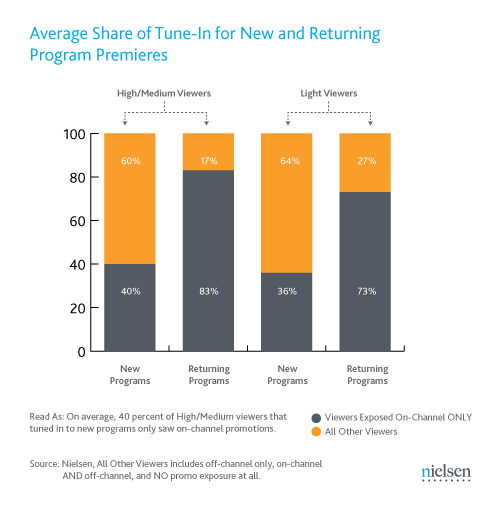Howard Shimmel, Executive Vice President, Client Insights, and Justin Rosen, Senior Manager, Media
On the heels of the Upfronts, TV programmers are gearing up for the 2012 fall season. With TV ad spending on the rise and more content choices available to consumers, garnering viewers—and corresponding ad dollars—is more important than ever. According to new research from Nielsen, promotion does drive viewership—and Nielsen is helping TV program marketers to understand just how much.
Media companies need to precisely maximize the use of all of their available marketing channels. Every marketing channel has real costs associated with it, whether it’s out of pocket dollars spent on advertising on TV and online, or the opportunity costs of on-channel and cross channel promotion.
Networks have the opportunity to be more precise in measuring the impact of promotions on actual ratings: overall, and by marketing channel.
These insights not only help to measure the ROI of specific campaigns, but also inform future campaign planning by answering questions about answer questions about optimal frequency, recency and messaging.
Our analysis of TV promotional campaigns discovered six takeaways for marketers:
- Promotion works! We precisely measured the impact of promotion on tune in for over 60 different programs, and found only one instance where promotion didn’t work. In that one outlier, the issue was scheduling against the NBA Finals.
- To maximize the number of potential new viewers, promote off your own air. Some networks may over-rely on their on-channel inventory, which only effectively reaches loyal, regular viewers. An analysis of promotional campaigns for a series of fall 2011 network premieres found that the average campaign reached 47 percent of Adults 18-49.The incremental reach from off-channel promotion averaged 4.4 reach points, including both cross-channel (free on sister networks) and paid ads on other networks. Importantly, among lighter network viewers, off-channel accounts for 7 incremental reach points of the 27 percent average reach.
- For new shows, off-channel promos are key. In our analysis, viewers to a new show that were only exposed to on-channel promotion make up below 40 percent of the premiere’s audience.
- For returning shows, sticking with promos on your own air may be enough. The largest share of viewers tuning in to the premiere is likely those who only saw on-channel ads, making up over 75 percent of the premiere’s audience.
- Promotions on premiere day are critical. Typically, around one-third of the total audience of a premiere was only exposed to a promo that day.
- Combine early and same-day promotions to pack the biggest punch. Those exposed both long before and day-of premiere typically account for nearly half of the premiere’s audience.
In today’s hyper-competitive media environment, TV marketers need to utilize a more scientific and tactical approach to promote programming. For the sake of the networks and the CMOs alike, it’s time to utilize measurement tools that can help networks optimize their program promotions—and then measure the direct impact on ratings. Only then can marketers determine if their on-channel vs. cross-channel/paid promotions mix is effective.




